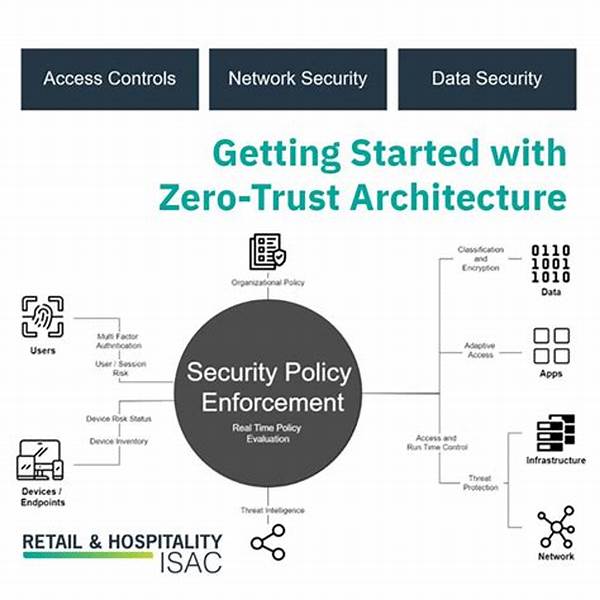In today’s digital age, organizations are constantly seeking robust ways to safeguard their sensitive data and systems. The Zero Trust Security Architecture has emerged as a pivotal model, shifting away from the traditional perimeter-based security approaches. It champions the idea that no user or system should be trusted by default, whether inside or outside the network perimeter. This strategy is increasingly relevant as cyber threats become more sophisticated and as organizations embrace remote work and cloud solutions.
Read Now : “color Changing Gaming Pad”
Key Principles of Zero Trust Security Architecture
Zero Trust Security Architecture is not just a technology; it is a comprehensive security philosophy. At its core, the model insists on verifying every user and device trying to access resources. Verification is continuous, using a dynamic approach to constantly assess the trustworthiness of both internal and external entities. This methodology ensures that only authenticated and authorized users or devices gain access to sensitive information.
Moreover, Zero Trust emphasizes the principle of least privilege. Once access is granted, users or systems are given the minimum level of access necessary to perform their tasks. This reduces the potential attack surface by ensuring that users have access only to the specific resources they need. Additionally, Zero Trust Security Architecture typically integrates advanced encryption methods, multi-factor authentication, and real-time monitoring to proactively address potential threats. By combining these mechanisms, organizations can create a resilient security posture, tailored to the evolving threat landscape.
Benefits of Implementing Zero Trust Security Architecture
1. Enhanced Data Protection: Zero Trust Security Architecture ensures that sensitive data is only accessible by verified and authorized users, minimizing the risk of unauthorized access.
2. Reduced Attack Surface: By limiting access to the necessary resources only, the model significantly reduces the potential points of vulnerability within an organization.
3. Continuous Monitoring: Through persistent surveillance and adaptive security measures, organizations can swiftly identify and respond to emerging threats.
4. Regulatory Compliance: Adopting Zero Trust can assist organizations in meeting various industry standards and regulatory requirements, such as GDPR and HIPAA.
5. Flexibility and Scalability: The architecture supports dynamic changes, allowing organizations to adjust their security measures as they grow and technology evolves.
Implementing Zero Trust Security Architecture in Modern Enterprises
Organizations pursuing Zero Trust Security Architecture must first conduct a thorough assessment of their current security landscape. This involves identifying key assets, data flows, and potential vulnerabilities within the existing network. By understanding these components, enterprises can better design a zero trust strategy tailored to their unique environment.
Next, enterprises should focus on implementing strong identity verification processes, such as multi-factor authentication, across all user access points. This step ensures that only legitimate users gain access to sensitive data and systems. Additionally, micro-segmentation of the network can be applied to create isolated zones, thereby limiting lateral movement of attackers within the system. By continuously monitoring these segments, organizations can promptly detect unauthorized activities and address them in real-time. Adopting such a comprehensive zero trust strategy not only strengthens security but also instills confidence among stakeholders regarding data protection measures.
Read Now : **avoid Excessive Pressure On Screens**
Challenges in Adopting Zero Trust Security Architecture
Adopting Zero Trust Security Architecture isn’t without its challenges. One of the primary hurdles is the integration with existing IT infrastructure. Many organizations may find it difficult to transition from their legacy systems to a zero trust model. This process requires a comprehensive overhaul of existing security protocols, which can be costly and time-consuming.
Furthermore, obtaining buy-in from all stakeholders is crucial. The shift to Zero Trust may initially meet resistance from within the organization, especially from those unfamiliar with the benefits of the model. It’s important to educate all users about the necessity of enhanced security measures and to demonstrate how Zero Trust can protect both individual data and corporate resources. Moreover, maintaining a Zero Trust Security Architecture demands ongoing monitoring and evaluation, necessitating dedicated resources and expertise. Despite these challenges, the long-term benefits offer compelling reasons for organizations to embrace Zero Trust.
Integrating Zero Trust Security Architecture with Cloud Solutions
As organizations increasingly migrate to cloud-based solutions, the relevance of Zero Trust Security Architecture becomes even more pronounced. Cloud environments inherently present different security challenges compared to traditional on-premises systems. The dynamic and distributed nature of cloud services requires a security model that doesn’t rely solely on perimeter defenses. Zero Trust Security Architecture provides a robust framework that aligns perfectly with cloud security needs.
In a cloud environment, Zero Trust ensures seamless and secure access to resources, regardless of the user’s location. By enforcing strict access controls, even legitimate users are constantly authenticated and authorized before accessing any application or data stored in the cloud. This is particularly beneficial for supporting remote workforces and ensuring that organizational data remains secure at all times. Additionally, Zero Trust enables centralized policy management, allowing IT teams to efficiently oversee security protocols across diverse cloud platforms. Implementing Zero Trust in conjunction with cloud solutions not only safeguards sensitive data but also optimizes operational efficiency and agility.
The Role of Artificial Intelligence in Zero Trust Security Architecture
Artificial Intelligence (AI) plays a pivotal role in enhancing Zero Trust Security Architecture. With the vast amount of data processed and analyzed, AI technologies can effectively monitor user behaviors, predict potential threats, and detect anomalies in real-time. This level of automation and insight empowers organizations to maintain a proactive security stance.
Preparing for a Zero Trust Future
As cybersecurity threats continue to evolve, preparing for a Zero Trust future is paramount for any organization aiming to protect its digital assets. The adoption of Zero Trust Security Architecture is a strategic move towards building a secure environment where trust is rigorously verified, and access is meticulously controlled. Bridging the gap between traditional and modern security measures, Zero Trust is not just about enhancing security; it’s about ensuring continuity and resilience in an ever-changing digital landscape.





